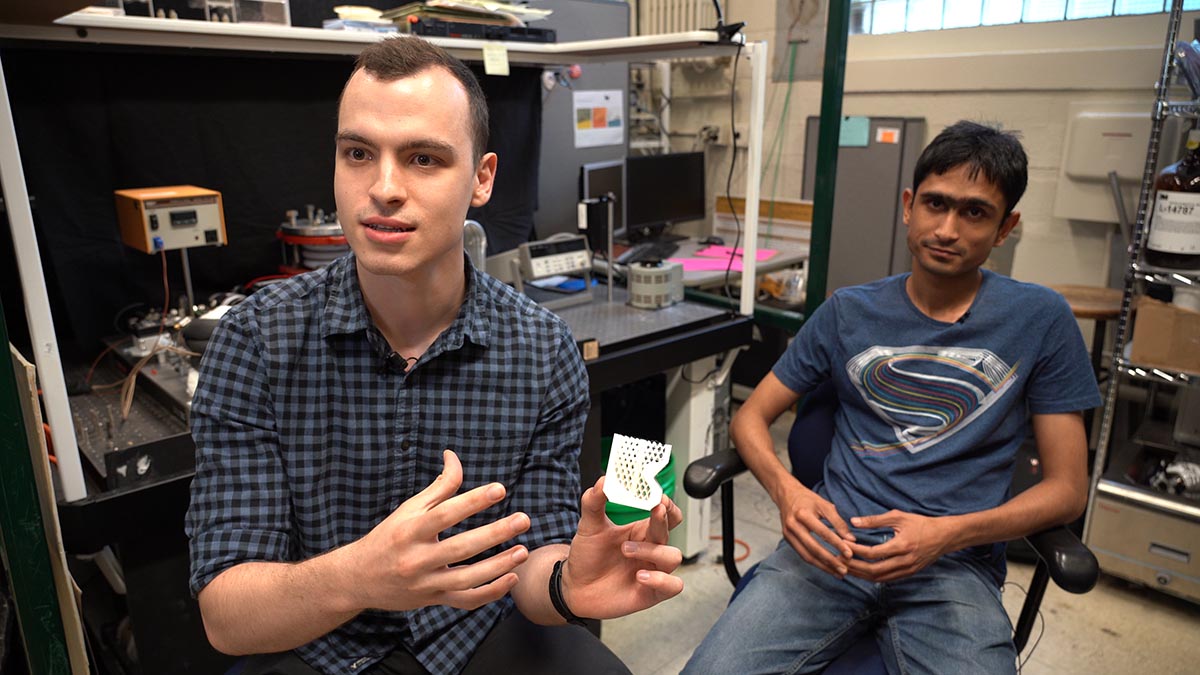Building the ideal heat sink
"There are big thermal challenges to today's electronic components," says Serdar Ozguc, a Ph.D. student at Purdue's Cooling Technologies Research Center (CTRC) under professor Justin Weibel. "People want smaller computers and phones, but at the same time, they want more power. The heat that is generated by these CPUs affects performance, so we have to find a way to dissipate that heat safely and efficiently." Prof. Weibel's lab investigates many novel ways of cooling, from using different materials and geometries, to boiling liquid in microchannels.
But there's nothing like a challenge to spur new ideas.
In this case, the challenge came from the American Society of Mechanical Engineers (ASME). Their committee on Heat Transfer in Electronic Equipment gave students a typical setup (a 70mm x 70mm heat source imitating a computer processor), and challenged them to custom-design a heat sink that could be built using additive manufacturing (3D printing). "With additive manufacturing," says Serdar, "we can design very complex geometries that would not be possible to manufacture with conventional methods." To even the playing field, all teams were restricted to the same dimensions; all would be printed by GE AddWorks on a GE Additive Concept Laser M2 machine; all would be the same material (aluminum); and all would be tested under the same conditions at Oregon State University. So the best heat sink would truly be a product of the best design process.
That's where Purdue's secret weapon came in. "To create the design, we used topology optimization," says Kalind Baraya, also a Ph.D. student in the CTRC. "It's a mathematical method for optimizing the material distribution in a given space. We start with an initial shape and tweak it a little to get an improved thermal resistance. Then we repeat the process, improving every time, until we get a final design that results in the best performance."
The resulting shape is something neither Serdar nor Kalind expected. Their heat sink has a gently sloping "L" shape on one side, and a protruding "d" shape on the other. The "d" shape causes airflow to back up and recirculate, spending more time in the heat sink, and removing more heat, before being channeled out by the "L" shape. "We didn't start with any pre-conceived notion about the shape," says Serdar. "Topology optimization sometimes spits out the craziest things, which are difficult to fabricate using conventional methods. But it was perfect for this contest, because additive manufacturing gives us the freedom to actually build these geometries."

However, it wasn't all computer-generated. Topology optimization gave them 2D images, which they then had to translate into 3D geometries using their own intuition. For example, the algorithm told them to put a porous structure in the middle. To fully leverage the capabilities of 3D printing, they created a rigid X-shaped lattice structure to achieve the required porosity. They also included pin fins extending the whole height of the heat sink. "That came from our own experience," says Serdar. "They weren't in the algorithm, but we knew that those would enhance the performance of the heat sink."
The design passed muster with the judges, and when delivered to GE Addworks machines, it printed successfully. It performed so well in testing, that Serdar and Kalind were invited to present its design at the Intersociety Conference on Thermal and Thermomechanical Phenomena in Electronic Systems (ITherm) in Las Vegas in May 2019.
Serdar and Kalind see big things for custom-printed heat sinks. "This was a custom-designed heat sink for one specific problem," says Kalind. "For all different situations that exist, we can use topology optimization to design an ideal solution."
"Additive manufacturing is also a big part of it," adds Serdar. "If you have a custom processor on a spacecraft, or a piece of medical equipment, or a supercomputer, it justifies 3D-printing a heat sink that is custom-designed and built just for that application."
Writer: Jared Pike, jaredpike@purdue.edu
Source: Justin Weibel, jaweibel@purdue.edu
